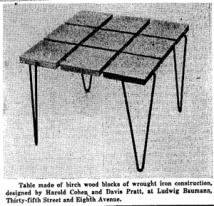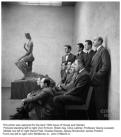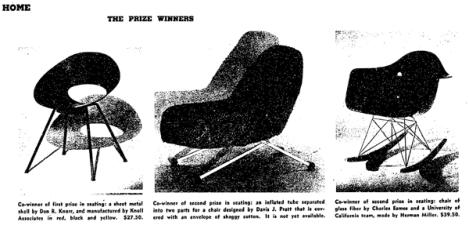Furniture Designs
Davis Pratt and Harold Cohen
In the late 1940s, Davis Pratt and Harold Cohen designed "modern" chairs, tables and other pieces of furniture. They
probably were based in Chicago and affiliated with the Institute of Design as students or teachers when some of this
furniture was being designed and marketed.
The news items below are related to the International Competition for Low-Cost Furniture that the Museum of
Modern Art and the Museum Design Project, Inc. held in the late 1940s. The contest appears to have taken place in
Chicago in late 1947. The winners were chosen in January 1948 but kept under wraps so the designs wouldn't be
pirated. New York Times author, Betty Pepis, wrote dozens of stories over three or four years about the contest,
exhibition, and the winners.
According to an article in the Dec 9, 1949 New York Times:
NEW CHAIRS, CHEST TO BE SHOWN SOON
Winners of Competition Last January to be Unveiled to Public in Spring
Three chairs and a chest, the lines of which have been kept a closely guarded secret since they won awards last
January in the International Competition for Low-Cost Furniture sponsored by the Museum of Modern Art, will be
revealed to the public in the spring of 1950.
Knoll Associates are manufacturing the chair designed by Don R. Knorr, first prize winner in the seating section.
Producing the chair, which demonstrates a new use of plastic, has required a great deal of research, it was explained
by Mrs. Florence Knoll.
Another new material is involved in the
construction of the second-prize seating
unit designed by Charles Eames in
cooperation with staff members of the
University of California. Although the chair
was originally planned in metal, the final
version will feature something
dramatically new. The Herman Miller
Company is making the chair.
Davis Pratt shared the second prize with
Mr. Eames and his conception of the chair
will be produced, as originally planned, in
metal, Irving Kitchner of the Bunting
Company of Philadelphia announced.
April 30, 1950 • New York Times
Low Cost Design
Originally announced in October, 1947 with $50,000 in prizes and grants....
13 months after the original announcement, a Jury of six men and a woman met to judge the entries....
Three thousand suggestions from thirty-two countries... 250 entrants from the United States and nearly 500
designers who lived in every other part of the world....
Some interesting new techniques suggested were gluing wood slats to canvas for a flexible chair seat and back,
using concealed rubber elements in a chair frame to give it special resiliency, making a plastic chair, legs arms and
all, in one piece from a single mold.
In each case the jury felt the prize-winners presented completely
new dolutions for construction problems. They particularly cited
the shaping of metal in the Knorr chair, the use of a material
formerly restricted to airplane wings for the Eames chair, the
inflated tube chosen for cushioning, by Davis Pratt, and the
tapered shape and tubular supports of the Latimer-Day storage
units.
The widest departure from conventional furniture in the 1941
[Organic Design] exhibit was said to be a form-fitting chair
presented by Charles Eames and Eero Sarrinen. It
unquestionably, and admittedly, is a forerunner of the 1950 prize-
winning shell designed by Mr. Eames with the help of his
University of California research team.
Good Design designers
Check out this 1949 picture of Davis Pratt and
other contest winning designers at grassrootsmodern.com
The Pratt-Cohen chair is in the collection of the Brooklyn Museum
at BrooklynMuseum.org
Homemakers' Tastes Like Those of Buyers
When it comes to home furnishings, the homemaker's taste does not differ greatly
from that of the professional buyer for a retail store, a recent poll conducted by the
Merchandise Mart, Chicago, shows. The poll was taken of visitors to the Good
Design exhibit, held under the joint auspices of the Mart and the Museum of Modern
Art of New York City.
Other object liked by both consumers and buyers, although in different degrees,
were a walnut storage cabinet with black metal hardware and wood-tipped metal
base, which was designed by Finn Juhl; an unusual lounge chair by Harold Cohen and
Davis Pratt, which has a black steel tubular frame and a woven fiber sling seat, and a combination desk and dressing
table of walnut and beech wood by the Danish designer Borge Mogensen.

New York Times - June 20, 1952

Pratt/Cohen Birch block table
New York Times - Jan 5, 1954
Design at Southern Illinois University





















